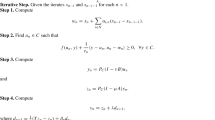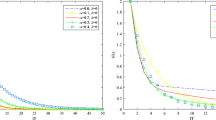Abstract
This paper presents a sequential quadratic programming algorithm for computing a stationary point of a mathematical program with linear complementarity constraints. The algorithm is based on a reformulation of the complementarity condition as a system of semismooth equations by means of Fischer-Burmeister functional, combined with a classical penalty function method for solving constrained optimization problems. Global convergence of the algorithm is established under appropriate assumptions. Some preliminary computational results are reported.
Similar content being viewed by others
References
J.V. Burke, “A robust trust region method for constrained nonlinear programming problems,” SIAM Journal on Optimization, vol. 2, pp. 325-347, 1992.
B. Chen and P.T. Harker, “A non-interior-point continuation method for linear complementarity problems,” SIAM Journal on Matrix Analysis and Applications, vol. 14, pp. 1168-1190, 1993.
R.W. Cottle, J.-S. Pang, and R.E. Stone, The Linear Complementarity Problem, Academic Press: Boston, 1992.
T. de Luca, F. Facchinei, and C. Kanzow, “A semismooth equation approach to the solution of nonlinear complementarity problems,” Mathematical Programming, vol. 75, pp. 407-440, 1996.
F. Facchinei, H. Jiang, and L. Qi, “A smoothing method for mathematical programs with equilibrium constraints,” manuscript, Dipartimento di Informatica e Sistemistica, Università di Roma “La Sapienza”, Rome, Italy, 1996.
F. Facchinei and J. Soares, “A new merit function for nonlinear complementarity problems and a related algorithm,” SIAM Journal on Optimization, vol. 7, pp. 225-247, 1997.
A. Fischer, “A special Newton-type optimization method,” Optimization, vol. 24, pp. 269-284, 1992.
A. Fischer, “An NCP-function and its use for the solution of complementarity problems,” in Recent Advances in Nonsmooth Optimization, D.-Z. Du, L. Qi, and R.S. Womersley (Eds.), World Scientific Publishers: Singapore, 1995, pp. 88-105.
A. Fischer, “A Newton-type method for positive semidefinite linear complementarity problems,” Journal of Optimization Theory and Applications, vol. 86, pp. 585-608, 1995.
M. Fukushima, “Merit functions for variational inequality and complementarity problems,” in Nonlinear Optimization and Applications, G. Di Pillo and F. Giannessi (Eds.), Plenum Press: New York, 1996, pp. 155- 170.
M. Fukushima and J.S. Pang, “Minimizing and stationary sequences of merit functions for complementarity problems and variational inequalities,” in Proceedings of the International Conference on Complementarity Problems, M.C. Ferris and J.S. Pang (Eds.), Baltimore, Maryland, 1995, SIAM Publications, forthcoming.
C. Geiger and C. Kanzow, “On the resolution of monotone complementarity problems,” Computational Optimization and Applications, vol. 5, pp. 155-173, 1996.
H. Jiang and L. Qi, “A new nonsmooth equations approach to nonlinear complementarity problems,” SIAM Journal on Control and Optimization, vol. 35, pp. 178-193, 1997.
J.J. Júdice and A.M. Faustino, “A sequential LCP method for bilevel linear programming,” Annals of Operations Research, vol. 34, pp. 89-106, 1992.
C. Kanzow, “Some noninterior continuation methods for linear complementarity problems,” manuscript, Institute of Applied Mathematics, University of Hamburg, Hamburg, Germany, 1995.
C. Kanzow and M. Fukushima, “Equivalence of the generalized complementarity problem to differentiable unconstrained minimization,” Journal of Optimization Theory and Applications, vol. 90, pp. 581-603, 1996.
M. Kočvara and J.V. Outrata, “On optimization systems governed by implicit complementarity problems,” Numerical Functional Analysis and Optimization, vol. 15, pp. 869-887, 1994.
M. Kočvara and J.V. Outrata, “On the solution of optimum design problems with variational inequalities,” in Recent Advances in Nonsmooth Optimization, D.Z. Du, L. Qi, and R.S. Womersley (Eds.), World Scientific Publishers: Singapore, 1995, pp. 172-192.
M. Kočvara and J.V. Outrata, “A nonsmooth approach to optimization problems with equilibrium constraints, in Proceedings of the International Conference on Complementarity Problems, M.C. Ferris and J.S. Pang (Eds.), Baltimore, Maryland, 1995, SIAM Publications, pp. 148-164.
M. Kojima, N. Megiddo, T. Noma, and A. Yoshise, “A unified approach to interior point algorithms for linear complementarity problems,” Springer-Verlag: Berlin, Heidelberg, 1991.
Z.-Q. Luo, J.-S. Pang, and D. Ralph, “Mathematical programs with equilibrium constraints,” Cambridge University Press, 1996.
Z.-Q. Luo, J.-S. Pang, D. Ralph, and S.-Q. Wu, “Exact penalization and stationary conditions of mathematical programs with equilibrium constraints,” Mathematical Programming, vol. 75, pp. 19-76, 1996.
J.V. Outrata, “On the numerical solution of a class of Stackelberg problems,” Zeitschrift für Operations Research, vol. 4, pp. 255-278, 1990.
J.V. Outrata, “On optimization problems with variational inequality constraints,” SIAM Journal on Optimization, vol. 4, pp. 340-357, 1994.
J.V. Outrata and J. Zowe, “A numerical approach to optimization problems with variational inequality constraints,” Mathematical Programming, vol. 68, pp. 105-130, 1995.
L. Qi and H. Jiang, “Semismooth Karush-Kuhn-Tucker equations and convergence analysis of Newton and quasi-Newton methods for solving these equations,” Mathematics of Operations Research, vol. 22, pp. 301- 325, 1997.
P. Tseng, “Growth behaviour of a class of merit functions for the nonlinear complementarity problem,” Journal of Optimization Theory and Applications, vol. 89, pp. 17-37, 1996.
N. Yamashita and M. Fukushima, “Modified Newton methods for solving a semismooth reformulation of monotone complementarity problems,” Mathematical Programming, vol. 76, pp. 469-491, 1997.
Author information
Authors and Affiliations
Rights and permissions
About this article
Cite this article
Fukushima, M., Luo, ZQ. & Pang, JS. A Globally Convergent Sequential Quadratic Programming Algorithm for Mathematical Programs with Linear Complementarity Constraints. Computational Optimization and Applications 10, 5–34 (1998). https://doi.org/10.1023/A:1018359900133
Issue Date:
DOI: https://doi.org/10.1023/A:1018359900133




